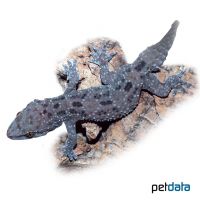Tropical House Gecko (Hemidactylus mabouia)
| Tropical House Gecko Hemidactylus mabouia | |
|---|---|
| Name | Tropical House Gecko |
| Name Lat. | Hemidactylus mabouia |
| Family | Geckos |
| Family lat. | Gekkonidae |
| Order | Scaled Reptiles |
| Order lat. | Squamata |
| Origin | Africa, Central & South America |
| Habitat | Humid savanna |
| Diet | Insects |
| Humidity | 60-80 % |
| Behavior | Nocturnal; ♂ territorial |
| Keeping | Individual, pair, harem |
| Care Level | Easy |
| Reproduction | Oviparous |
| Housing | Semi-humid terrarium |
| Life Span | 6-8 years |
| Protection | No |
| Metric Units | |
| Size | 16 cm |
| Temperature | 25-28 °C |
| Temperature Local | 35 °C |
| Housing Size | 60 x 60 x 80 cm |
| US Units | |
| Size | 6.3" |
| Temperature | 77-82 °F |
| Temperature Local | 95 °F |
| Housing Size | 25" x 25" x 30" |
Distribution and habitat
The nocturnal domestic geckos originate from the wet savannahs of West Africa. Through displacement, they are now also native to Central and South America as well as Caribbean islands. They are crop followers, living mainly on house walls, stones, rocks, bushes and trees.
Maintenance
Minimum dimensions for the terrarium, according to the size and number of animals
| 1-2 animals | 6KRL x 6KRL x 8KRL (L x W x H) |
Head-torso length (KRL) is measured on the largest animal. For each additional animal, increase the footprint by 15%. A terrarium of L 50 x W 50 x H 80 cm for 2-4 animals is recommended, which should be placed in a quiet and vibration-free place.
They need a terrarium structured with roots, climbing branches, cork tubes and bamboo sticks (hiding places and privacy screen), a substrate of sand-humus mixture and rubble, a small water container and potted small climbing plants. The substrate should always be kept slightly moist. Several times a day the inside of the terrarium (but not directly the animals) should be finely sprayed with water (humidity), better is a rain or mist system.
| Temp.day: 25-28 °C | Temp.night: 20-23 °C | Temp.local: up to 35 °C | Humidity: 50-80 |
Thermostatically controlled floor heating is recommended. The lighting duration must be 12-14 hrs. Daylight fluorescent tubes are ideal. A special UV light is not necessary.
Diet
The food supply consists of live insects, such as crickets, house crickets, grasshoppers, millipedes, zophobas and mealybug larvae. Alternatively, special ready-made food for insectivorous reptiles can be offered, possibly with tweezers for habituation. Wax moths should only be fed in small amounts to adults, but not to juveniles, because of their large fat content. Regular addition of minerals and vitamins (dusting of food) is important. Young animals should be offered food daily, adult animals 4-5 times a week. Drinking water must always be available
A regular and varied diet promotes health and prevents deficiency symptoms.
Reproduction and breeding
Adult males are usually larger and more powerfully built than females and can be recognized by their preanal pores (pore-like openings in front of the anal cleft).
The female lays her hard-shelled eggs (1-3 pieces) in the decoration several times a year. At a temperature of 28-30 °C the incubation period is 40-50 days. Breeding is not practiced. As first food for the young animals small insects like fruit flies and micro crickets are suitable
The life expectancy can be 6-8 years.
Important
Their toes have claws and a double row of adhesive lamellae.
Sunny places with radiant heat are readily accepted.
Adult males behave very territorial and are incompatible with each other. Keeping a group, one male with 2-3 females is unproblematic.
For the resting phase, the lighting duration is shortened by 2-3 hours for about two months and the temperature is lowered by 3-4 °C
With fruit and honey water as food for the feeders, their quality can be upgraded.
The terrarium must have good ventilation without drafts and meet the species specific needs. Measuring devices such as thermometers, hygrometers, etc. are necessary. The lighting has to correspond to the species-specific day-night rhythm and has to be placed in such a way that the animals cannot injure themselves. The terrarium should be locked in such a way that neither unauthorized persons can open it nor the animals can escape. Contamination must be removed regularly.
Further literature can be found in your pet store.
References
Text: petdata; Image: petdata
Source: BMELV (1997): Tierschutzgutachten - Mindestanforderungen an die Haltung von Reptilien; ENGELMANN (2006): Zootierhaltung - Tiere in menschlicher Obhut: Reptilien und Amphibien, Harri Deutsch Verlag; BILL BRANCH (1994): Field Guide to Snakes and Other Reptiles of Southern Africa, Struik Puplishers Ltd.
- Gemäß § 21 Abs. 5 Tierschutzgesetz idgF
